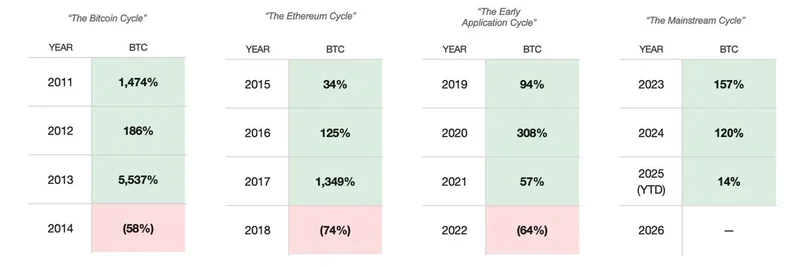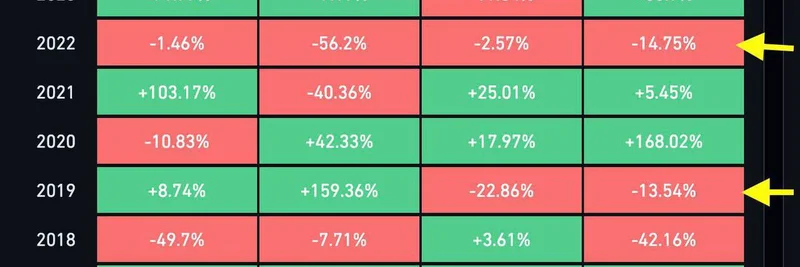In the fast-paced world of cryptocurrency, patterns like Bitcoin's 4-year cycle have long guided investors' decisions. But what happens when everyone starts betting on the same pattern? Bitwise CEO Hunter Horsley recently shared a thought-provoking tweet that challenges this conventional wisdom, suggesting the cycle might be on the verge of breaking due to collective behavior.
Horsley's post breaks down the historical performance of Bitcoin across different cycles, illustrated in a clear chart that maps out yearly returns. Here's the visual for context:
The chart divides Bitcoin's history into phases: "The Bitcoin Cycle" (2011-2014), "The Ethereum Cycle" (2015-2018), "The Early Application Cycle" (2019-2022), and "The Mainstream Cycle" (2023-2026). It highlights massive gains in bull years, like 5,537% in 2013, followed by sharp drops in bear years, such as -58% in 2014. As of 2025 year-to-date, Bitcoin is up just 14%, a far cry from previous cycle highs.
Horsley argues that the common belief in these 4-year cycles—tied to Bitcoin's halving events, where mining rewards are cut in half every four years—could ironically cause its downfall. Here's how he sees it unfolding:
First, many investors expect 2026 to be a down year based on past patterns, prompting them to sell off holdings in 2025 to avoid potential losses.
This mass selling creates a self-fulfilling prophecy, turning 2025 into the actual down year and disrupting the established cycle.
Once the pattern breaks, 2026 becomes unpredictable, potentially opening up for unexpected gains as the market resets.
He notes that Bitcoin is currently only up 2.5% year-to-date in 2025, which might already signal this shift. In a follow-up, Horsley references an earlier post emphasizing how the launch of Bitcoin ETFs and a new U.S. administration have changed market dynamics, bringing in new players and possibly ending the old cycle era.
This perspective resonates in the replies. For instance, user @shanaka86 points out that once a cycle becomes a "meme"—a widely recognized and traded idea—it loses its edge, as rational sellers front-run the expected pain, setting up for upside surprises later. Others echo this, noting that cycles die from over-participation, not randomness.
For meme token enthusiasts, this is particularly relevant. Meme coins often ride the waves of broader crypto sentiment, amplified by Bitcoin's movements. If the 4-year cycle breaks, it could mean less predictable but potentially more volatile opportunities in 2026. Projects built on hype and community, like many meme tokens, might thrive in this "open season" where traditional patterns no longer hold sway.
Horsley's take reminds us that crypto markets are as much about psychology as they are about technology. As blockchain adoption grows mainstream, old models may give way to new ones. Whether you're holding Bitcoin or diving into the latest meme coin, staying adaptable is key.
If you're tracking meme tokens and how they intersect with these macro trends, keep an eye on updates here at Meme Insider. What do you think—will the cycle hold, or is 2026 set for a surprise rally?




